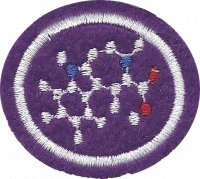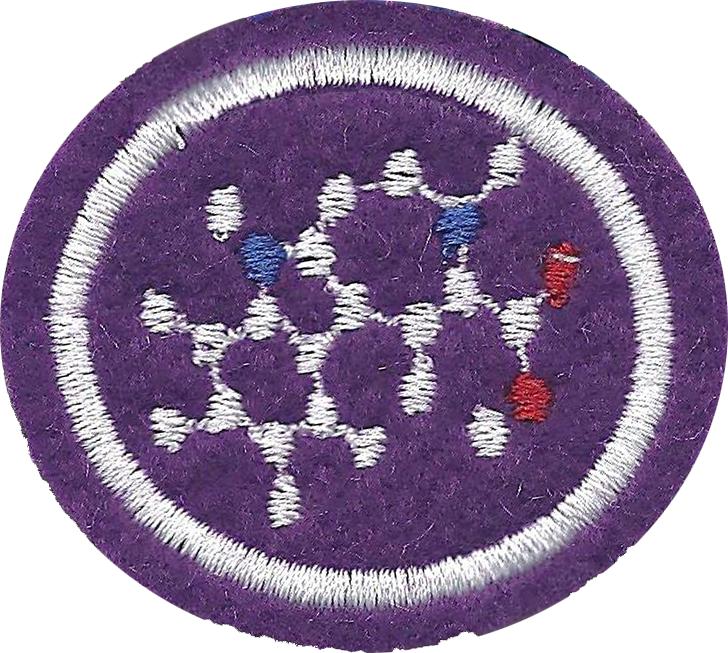Difference between revisions of "AY Honors/Biochemistry/Answer Key/es"
From Pathfinder Wiki
< AY Honors | BiochemistryAY Honors/Biochemistry/Answer Key/es
(Created page with "{{clear}}") |
(Updating to match new version of source page) |
||
| (35 intermediate revisions by 2 users not shown) | |||
| Line 1: | Line 1: | ||
| − | + | {{HonorSubpage}} | |
| − | |||
| − | {{ | ||
| − | |||
| − | |||
| − | |||
| − | |||
| − | |||
| − | |||
| − | |||
| − | |||
| − | }} | ||
| − | |||
| − | |||
| − | |||
<section begin="Body" /> | <section begin="Body" /> | ||
{{ansreq|page={{#titleparts:{{PAGENAME}}|2|1}}|num=1}} | {{ansreq|page={{#titleparts:{{PAGENAME}}|2|1}}|num=1}} | ||
<noinclude></noinclude> | <noinclude></noinclude> | ||
| − | <!-- 1. | + | <!-- 1. Definir los siguientes términos: --> |
<noinclude></noinclude> | <noinclude></noinclude> | ||
| Line 37: | Line 23: | ||
<noinclude></noinclude> | <noinclude></noinclude> | ||
| − | + | {{clear}} | |
<noinclude></noinclude> | <noinclude></noinclude> | ||
| Line 43: | Line 29: | ||
{{ansreq|page={{#titleparts:{{PAGENAME}}|2|1}}|num=1d}} <!--T:6--> | {{ansreq|page={{#titleparts:{{PAGENAME}}|2|1}}|num=1d}} <!--T:6--> | ||
<noinclude></noinclude> | <noinclude></noinclude> | ||
| − | |||
<noinclude></noinclude> | <noinclude></noinclude> | ||
| Line 50: | Line 35: | ||
<noinclude></noinclude> | <noinclude></noinclude> | ||
| − | + | {{clear}} | |
<noinclude></noinclude> | <noinclude></noinclude> | ||
| Line 57: | Line 42: | ||
<noinclude></noinclude> | <noinclude></noinclude> | ||
| − | + | {{clear}} | |
<noinclude></noinclude> | <noinclude></noinclude> | ||
| Line 64: | Line 49: | ||
<noinclude></noinclude> | <noinclude></noinclude> | ||
| − | + | {{clear}} | |
<noinclude></noinclude> | <noinclude></noinclude> | ||
| Line 70: | Line 55: | ||
{{ansreq|page={{#titleparts:{{PAGENAME}}|2|1}}|num=1h}} <!--T:10--> | {{ansreq|page={{#titleparts:{{PAGENAME}}|2|1}}|num=1h}} <!--T:10--> | ||
<noinclude></noinclude> | <noinclude></noinclude> | ||
| − | |||
<noinclude></noinclude> | <noinclude></noinclude> | ||
| Line 82: | Line 66: | ||
<noinclude></noinclude> | <noinclude></noinclude> | ||
| − | + | {{clear}} | |
<noinclude></noinclude> | <noinclude></noinclude> | ||
| Line 94: | Line 78: | ||
{{ansreq|page={{#titleparts:{{PAGENAME}}|2|1}}|num=2}} | {{ansreq|page={{#titleparts:{{PAGENAME}}|2|1}}|num=2}} | ||
<noinclude></noinclude> | <noinclude></noinclude> | ||
| − | <!-- 2. | + | <!-- 2. ¿Cuál es la importancia del agua en los organismos? ¿Cuáles son las principales características físicas y químicas de la molécula de agua? --> |
<noinclude></noinclude> | <noinclude></noinclude> | ||
| Line 100: | Line 84: | ||
{{ansreq|page={{#titleparts:{{PAGENAME}}|2|1}}|num=3}} | {{ansreq|page={{#titleparts:{{PAGENAME}}|2|1}}|num=3}} | ||
<noinclude></noinclude> | <noinclude></noinclude> | ||
| − | <!-- 3. | + | <!-- 3. ¿Qué significa metabolismo? --> |
<noinclude></noinclude> | <noinclude></noinclude> | ||
| Line 106: | Line 90: | ||
{{ansreq|page={{#titleparts:{{PAGENAME}}|2|1}}|num=4}} | {{ansreq|page={{#titleparts:{{PAGENAME}}|2|1}}|num=4}} | ||
<noinclude></noinclude> | <noinclude></noinclude> | ||
| − | <!-- 4. | + | <!-- 4. Bioquímicamente, ¿por qué sentimos hambre? --> |
<noinclude></noinclude> | <noinclude></noinclude> | ||
| Line 112: | Line 96: | ||
{{ansreq|page={{#titleparts:{{PAGENAME}}|2|1}}|num=5}} | {{ansreq|page={{#titleparts:{{PAGENAME}}|2|1}}|num=5}} | ||
<noinclude></noinclude> | <noinclude></noinclude> | ||
| − | <!-- 5. | + | <!-- 5. Explicar cómo ocurre la vía de la glucosa. --> |
| − | |||
| − | + | {{clear}} | |
{{clear}} | {{clear}} | ||
| Line 123: | Line 106: | ||
{{ansreq|page={{#titleparts:{{PAGENAME}}|2|1}}|num=6}} | {{ansreq|page={{#titleparts:{{PAGENAME}}|2|1}}|num=6}} | ||
<noinclude></noinclude> | <noinclude></noinclude> | ||
| − | <!-- 6. | + | <!-- 6. ¿Qué células humanas dependen solo de esta vía para obtener energía? --> |
| − | |||
<noinclude></noinclude> | <noinclude></noinclude> | ||
| Line 130: | Line 112: | ||
{{ansreq|page={{#titleparts:{{PAGENAME}}|2|1}}|num=7}} | {{ansreq|page={{#titleparts:{{PAGENAME}}|2|1}}|num=7}} | ||
<noinclude></noinclude> | <noinclude></noinclude> | ||
| − | <!-- 7. | + | <!-- 7. ¿Qué molécula une la vía de la glucosa y el Ciclo de Krebs? --> |
| − | |||
<noinclude></noinclude> | <noinclude></noinclude> | ||
| Line 137: | Line 118: | ||
{{ansreq|page={{#titleparts:{{PAGENAME}}|2|1}}|num=8}} | {{ansreq|page={{#titleparts:{{PAGENAME}}|2|1}}|num=8}} | ||
<noinclude></noinclude> | <noinclude></noinclude> | ||
| − | <!-- 8. | + | <!-- 8. ¿Cuál es la importancia del Ciclo de Krebs? --> |
| − | |||
| − | + | {{clear}} | |
| − | |||
| − | |||
| − | |||
| − | |||
<noinclude></noinclude> | <noinclude></noinclude> | ||
| Line 150: | Line 126: | ||
{{ansreq|page={{#titleparts:{{PAGENAME}}|2|1}}|num=9}} | {{ansreq|page={{#titleparts:{{PAGENAME}}|2|1}}|num=9}} | ||
<noinclude></noinclude> | <noinclude></noinclude> | ||
| − | <!-- 9. | + | <!-- 9. ¿Cuáles son las funciones de los lípidos? --> |
<noinclude></noinclude> | <noinclude></noinclude> | ||
| Line 156: | Line 132: | ||
{{ansreq|page={{#titleparts:{{PAGENAME}}|2|1}}|num=10}} | {{ansreq|page={{#titleparts:{{PAGENAME}}|2|1}}|num=10}} | ||
<noinclude></noinclude> | <noinclude></noinclude> | ||
| − | <!-- 10. | + | <!-- 10. ¿Por qué los lípidos son insolubles en el agua? --> |
<noinclude></noinclude> | <noinclude></noinclude> | ||
| Line 162: | Line 138: | ||
{{ansreq|page={{#titleparts:{{PAGENAME}}|2|1}}|num=11}} | {{ansreq|page={{#titleparts:{{PAGENAME}}|2|1}}|num=11}} | ||
<noinclude></noinclude> | <noinclude></noinclude> | ||
| − | <!-- 11. | + | <!-- 11. ¿Por qué los lípidos, y no la glucosa, se usan para el almacenamiento de energía? --> |
| − | |||
<noinclude></noinclude> | <noinclude></noinclude> | ||
| Line 169: | Line 144: | ||
{{ansreq|page={{#titleparts:{{PAGENAME}}|2|1}}|num=12}} | {{ansreq|page={{#titleparts:{{PAGENAME}}|2|1}}|num=12}} | ||
<noinclude></noinclude> | <noinclude></noinclude> | ||
| − | <!-- 12. | + | <!-- 12. ¿Qué es beta oxidación? ¿Por qué ésta vía recibe éste nombre? --> |
<noinclude></noinclude> | <noinclude></noinclude> | ||
| Line 175: | Line 150: | ||
{{ansreq|page={{#titleparts:{{PAGENAME}}|2|1}}|num=13}} | {{ansreq|page={{#titleparts:{{PAGENAME}}|2|1}}|num=13}} | ||
<noinclude></noinclude> | <noinclude></noinclude> | ||
| − | <!-- 13. | + | <!-- 13. ¿Qué son aminoácidos esenciales y no esenciales? --> |
| − | + | {{clear}} | |
| − | + | {{clear}} | |
| − | + | {{clear}} | |
| − | + | {{clear}} | |
<noinclude></noinclude> | <noinclude></noinclude> | ||
| Line 189: | Line 164: | ||
{{ansreq|page={{#titleparts:{{PAGENAME}}|2|1}}|num=14}} | {{ansreq|page={{#titleparts:{{PAGENAME}}|2|1}}|num=14}} | ||
<noinclude></noinclude> | <noinclude></noinclude> | ||
| − | <!-- 14. | + | <!-- 14. ¿Qué son cuerpos cetónicos, dónde se producen y cuáles son las consecuencias del exceso de su producción? --> |
<noinclude></noinclude> | <noinclude></noinclude> | ||
| Line 195: | Line 170: | ||
{{ansreq|page={{#titleparts:{{PAGENAME}}|2|1}}|num=15}} | {{ansreq|page={{#titleparts:{{PAGENAME}}|2|1}}|num=15}} | ||
<noinclude></noinclude> | <noinclude></noinclude> | ||
| − | <!-- 15. | + | <!-- 15. ¿Qué compuestos se forman por la unión de los aminoácidos? ¿Cuáles son las principales funciones de estos compuestos? --> |
| − | + | {{clear}} | |
<noinclude></noinclude> | <noinclude></noinclude> | ||
| Line 203: | Line 178: | ||
{{ansreq|page={{#titleparts:{{PAGENAME}}|2|1}}|num=16}} | {{ansreq|page={{#titleparts:{{PAGENAME}}|2|1}}|num=16}} | ||
<noinclude></noinclude> | <noinclude></noinclude> | ||
| − | <!-- 16. | + | <!-- 16. ¿Cuál es la importancia de los ácidos nucleicos? ¿Cómo es su estructura y cuáles son sus componentes? --> |
<noinclude></noinclude> | <noinclude></noinclude> | ||
| Line 209: | Line 184: | ||
{{ansreq|page={{#titleparts:{{PAGENAME}}|2|1}}|num=17}} | {{ansreq|page={{#titleparts:{{PAGENAME}}|2|1}}|num=17}} | ||
<noinclude></noinclude> | <noinclude></noinclude> | ||
| − | <!-- 17. | + | <!-- 17. Dibujar una molécula de ADN, con cuatro nucleótidos, nombrando sus componentes. --> |
<noinclude></noinclude> | <noinclude></noinclude> | ||
{{CloseReq}} <!-- 17 --> | {{CloseReq}} <!-- 17 --> | ||
<noinclude></noinclude> | <noinclude></noinclude> | ||
| − | == | + | ==Referencias== |
| − | |||
| − | |||
<noinclude></noinclude> | <noinclude></noinclude> | ||
| − | + | {{CloseHonorPage}} | |
Latest revision as of 21:53, 13 July 2022
Bioquímica
Nivel de destreza
3
Año
2012
Version
23.12.2025
Autoridad de aprobación
División Sudamericana
1
Definir los siguientes términos:
1a
Hidratos de carbono
1b
Lípido
1c
Ácido graso
1d
Proteína
1e
Péptido
1f
Enzima
1g
Aminoácido
1h
Ácido nucleico
1i
Hidrofílico e hidrofóbico
1j
Triglicérido
1k
Monosacárido
2
¿Cuál es la importancia del agua en los organismos? ¿Cuáles son las principales características físicas y químicas de la molécula de agua?
3
¿Qué significa metabolismo?
4
Bioquímicamente, ¿por qué sentimos hambre?
5
Explicar cómo ocurre la vía de la glucosa.
6
¿Qué células humanas dependen solo de esta vía para obtener energía?
7
¿Qué molécula une la vía de la glucosa y el Ciclo de Krebs?
8
¿Cuál es la importancia del Ciclo de Krebs?
9
¿Cuáles son las funciones de los lípidos?
10
¿Por qué los lípidos son insolubles en el agua?
11
¿Por qué los lípidos, y no la glucosa, se usan para el almacenamiento de energía?
12
¿Qué es beta oxidación? ¿Por qué ésta vía recibe éste nombre?
13
¿Qué son aminoácidos esenciales y no esenciales?
14
¿Qué son cuerpos cetónicos, dónde se producen y cuáles son las consecuencias del exceso de su producción?
15
¿Qué compuestos se forman por la unión de los aminoácidos? ¿Cuáles son las principales funciones de estos compuestos?
16
¿Cuál es la importancia de los ácidos nucleicos? ¿Cómo es su estructura y cuáles son sus componentes?
17
Dibujar una molécula de ADN, con cuatro nucleótidos, nombrando sus componentes.



